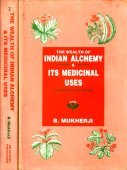Jvaratisara, Jvara-atisara, Jvarātisāra: 7 definitions
Introduction:
Jvaratisara means something in Hinduism, Sanskrit, Marathi. If you want to know the exact meaning, history, etymology or English translation of this term then check out the descriptions on this page. Add your comment or reference to a book if you want to contribute to this summary article.
In Hinduism
Ayurveda (science of life)
Rasashastra (Alchemy and Herbo-Mineral preparations)
Source: Wisdom Library: Rasa-śāstraJvarātisāra (ज्वरातिसार) refers to “fever with diarrhoea” defined in the fourth volume of the Rasajalanidhi (chapter 3, jvarātisāra: fever with diarrhoea). Sometimes, fever (jvara), due to an excess of pitta, is attended with diarrhoea (atisāra) due to the same cause. Diarrhoea also is sometimes attended with fever. Such a combination of fever and diarrhoea is called “jvarātisāra”. One suffering from jvarātisāra should, first of all, be made to fast and to take such medicines as can digest the undigested chyle, which is invariably a partial cause of both fever and diarrhoea. Fasting and digesting medicines do away with the undigested chyle, and help to pacify the diseases.
Kalpa (Formulas, Drug prescriptions and other Medicinal preparations)
Source: Shodhganga: Edition translation and critical study of yogasarasamgrahaJvarātisāra (ज्वरातिसार) refers to “fever with diarrhea” and is one of the various diseases mentioned in the 15th-century Yogasārasaṅgraha (Yogasara-saṅgraha) by Vāsudeva: an unpublished Keralite work representing an Ayurvedic compendium of medicinal recipes. The Yogasārasaṃgraha [mentioning jvarātisāra] deals with entire recipes in the route of administration, and thus deals with the knowledge of pharmacy (bhaiṣajya-kalpanā) which is a branch of pharmacology (dravyaguṇa).
Unclassified Ayurveda definitions
Source: Wisdom Library: Āyurveda and botanyJvarātisāra (ज्वरातिसार) refers to a combination of fever (jvara) and diarrhoea (atisāra) that is caused due to an excess of pitta.

Āyurveda (आयुर्वेद, ayurveda) is a branch of Indian science dealing with medicine, herbalism, taxology, anatomy, surgery, alchemy and related topics. Traditional practice of Āyurveda in ancient India dates back to at least the first millenium BC. Literature is commonly written in Sanskrit using various poetic metres.
Languages of India and abroad
Marathi-English dictionary
Source: DDSA: The Molesworth Marathi and English Dictionaryjvarātisāra (ज्वरातिसार).—m S Diarrhoea or dysentery with fever.
Marathi is an Indo-European language having over 70 million native speakers people in (predominantly) Maharashtra India. Marathi, like many other Indo-Aryan languages, evolved from early forms of Prakrit, which itself is a subset of Sanskrit, one of the most ancient languages of the world.
Sanskrit dictionary
Source: Cologne Digital Sanskrit Dictionaries: Monier-Williams Sanskrit-English DictionaryJvarātīsāra (ज्वरातीसार):—[from jvara > jvar] m. diarrhoea with fever, [Bhāvaprakāśa vii, 15, 1 ff.]
[Sanskrit to German]
Sanskrit, also spelled संस्कृतम् (saṃskṛtam), is an ancient language of India commonly seen as the grandmother of the Indo-European language family (even English!). Closely allied with Prakrit and Pali, Sanskrit is more exhaustive in both grammar and terms and has the most extensive collection of literature in the world, greatly surpassing its sister-languages Greek and Latin.
Kannada-English dictionary
Source: Alar: Kannada-English corpusJvarātisāra (ಜ್ವರಾತಿಸಾರ):—[noun] the condition of having fever accompanied by excessive frequency and looseness of bowel movements.
Kannada is a Dravidian language (as opposed to the Indo-European language family) mainly spoken in the southwestern region of India.
See also (Relevant definitions)
Partial matches: Jvara, Atisara.
Starts with: Jvaratisaram.
Query error!
Full-text: Jvaratisaram, Atisara, Kanakaprabha, Sukhasanjivani, Siddhapraneshvara, Kanakasundara, Gaganasundara, Pretasanjivana, Grahani.
Relevant text
Search found 11 books and stories containing Jvaratisara, Jvara-atisara, Jvara-atisāra, Jvarātisāra, Jvarātīsāra; (plurals include: Jvaratisaras, atisaras, atisāras, Jvarātisāras, Jvarātīsāras). You can also click to the full overview containing English textual excerpts. Below are direct links for the most relevant articles:
Atharvaveda and Charaka Samhita (by Laxmi Maji)
Yogaratnākara (Āyurveda book) < [Chapter 1 - Introduction]
Rasa Jala Nidhi, vol 4: Iatrochemistry (by Bhudeb Mookerjee)
Part 1 - Symptoms of the Jvaratisara disease < [Chapter III - Jvaratisara fever with diarrhoea]
Notices of Sanskrit Manuscripts (by Rajendralala Mitra)
"Bala (Sida Cordifolia): An Ayurvedic Literary Review" < [Volume 8, Issue 3: May - June 2021]
The glorious history of ksharasutra – a literature review < [Volume 5, Issue 5: September-October 2018]
World Journal of Pharmaceutical Research
Study of Samanyaj Vyadhi and Sankhya Samprapti in Charak Samhita. < [2021: Volume 10, July special issue 9]
Role of vatsanabha in infectious diseases < [2021: Volume 10, April issue 4]
Review of Panchakarma for surgical conditions in Ayurveda. < [2020: Volume 9, September issue 10]
Sushruta Samhita, volume 4: Cikitsasthana (by Kaviraj Kunja Lal Bhishagratna)
Related products
